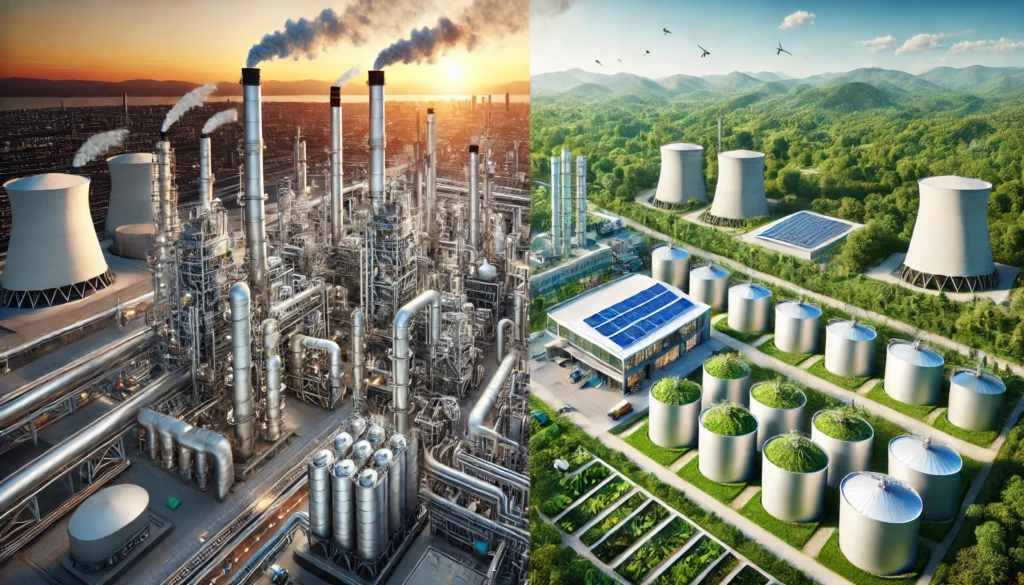
Introduction: The cost of powering the world
Imagine yourself standing at a gas station, watching automobiles fuel up. On one side, a driver is fueling up with traditional gasoline refined from petroleum. On the other, someone else is filling up with a biofuel blend, a newer alternative derived from organic materials. Both fuel engines, but their production processes, costs, and environmental impacts differ significantly. As the world struggles with fossil fuel to renewable energy conversion, understanding the economics of petrochemical refining versus biofuel processing is vital.
This article explores the financial aspects of these two fuel industries, comparing capital investment, production expenses, market influences, and long-term sustainability. Whether you work in energy, industry, or simply have an interest in fuel production economics, this breakdown offers valuable insights.
Understanding petrochemical refining
What are petrochemicals?
Petrochemicals are chemical substances extracted from petroleum and natural gas. They serve as the backbone of modern industries, appearing in plastics, medications, fertilizers, and fuel. Despite concerns over sustainability, the petrochemical industry remains highly profitable, largely due to global demand and cost advantages.
How petrochemical oils are refined
Refining petroleum is a process by which crude oil is transformed into valuable products like gasoline, diesel, and jet fuel. The key steps are:
- Distillation: Crude oil is separated into fractions of varying boiling points.
- Cracking: Heavy hydrocarbons are broken down into lighter fuels.
- Reforming & Blending: Chemical treatments improve fuel quality.
- Desulfurization & Treatment: Impurities are treated to standards.
This refining process is in place, with decades of infrastructure construction to ensure maximum efficiency and scalability. However, the environmental impacts of petrochemical oil are becoming harder to ignore, as refineries contribute to emissions and pollution.
The costs of petrochemical refining
Capital investment & infrastructure costs
Construction of an oil refinery is a capital-expensive venture. Construction of a new plant costs between $5 billion and $15 billion based on the capacity and technology applied. Refineries that exist and are in use also incur significant maintenance cost, where some of them allocate up to $1 billion annually in upgrading and meeting regulations (EIA).
Production costs
It costs an average of $1.07 to process crude to diesel fuel or gasoline in the United States prior to taxes and distribution expenses (Statista). However, production fluctuates based on crude prices between $50 and $120 per barrel in recent years depending on market and geopolitical forces.
Exploring biofuel processing
How biofuels are made
Biofuels come from plant-based sources such as vegetable oils, animal fats, and agricultural waste. Two of the best-known are:
- Ethanol – Produced by fermenting crop sugars like corn and sugarcane.
- Biodiesel – Produced by transesterification, a chemical process that converts fats into fuel.
The costs of biofuel processing
Capital investment
The cost of building a large-scale biofuel plant is much lower than an oil refinery, between $200 million and $1 billion. But filling up the growing demand for petroleum refining remains challenging.
Production costs
- Ethanol: The price ranges from $1.20 to $2.00 per gallon, depending on feedstock price and processing technology.
- Biodiesel: It is as much as $2.50 per gallon, especially when made from vegetable oils instead of waste oils.
Market challenges & government incentives
The 2025 world petrochemical market outlook Studies indicate that fossil fuels will remain dominant, but biofuels are gaining traction due to increasing government support and policy incentives. Government incentives like the U.S. Renewable Fuel Standard and the European Union biofuel directive provide subsidies and incentives to compensate for higher production cost.
Comparing the environmental & economic impacts
Environmental impacts of petrochemical oil
Petroleum refining contributes to:
- Refining and combustion release enormous quantities of CO₂.
- Pollutes the atmosphere with sulfur dioxide and nitrogen oxides.
- Potentially ends up in the environment as a byproduct.
Environmental impacts of biofuels
Biofuels are often promoted as “clean energy,” but they have their own challenges:
- Smaller carbon footprint – Biofuels emit reduced net quantities of CO₂ compared to fossil fuels.
- Land use concerns – Higher biofuel production can lead to deforestation and biodiversity loss.
- Energy balance issues – Great amounts of water and fertilizer are required for certain biofuels.
Economic viability & future outlook
Why the Petrochemical Industry Remains Profitable
Despite environmental concerns, petroleum remains dominant due to:
- Installed facilities – Billions have been invested in refineries as well as global supply chains.
- Market needs – Aviation, shipping, and heavy industries continue to consume fossil fuels.
- Lower production cost – In spite of varying crude oil prices, petroleum remains inexpensive. Petrochemical vs synthetic oils discussions highlight petroleum’s cost advantages in industrial applications.
Challenges facing the petrochemical oil sector
- Regulatory pressures – Emissions tightening regulations are pushing up compliance costs.
- Crude oil reserves are declining—new deposits are discovered, but their long-term supply remains uncertain.
- Competition from Renewables – Demand for clean fuels threatens market share.
Future of biofuels
Biofuels hold potential for growth, but face hurdles:
- High production costs – Subsidies excluded, most biofuels are expensive.
- Feedstock limitations – Crop dependence raises food vs. fuel controversy.
- Technology innovations – Advances in algae biofuels and cellulosic ethanol could tilt the cost-benefit balance.
Conclusion: Which is the better investment?
Petrochemical refining and biofuel processing have distinctive cost structures, respond to market forces, and impact the environment differently. While petrochemical fuels remain the leaders due to current infrastructure and lower costs, biofuels are gaining popularity with government incentives and technology innovations.
The single most critical question to ask is: Can biofuels compete on a price basis without subsidy with petrochemicals, or will fossil fuels dominate for decades?




